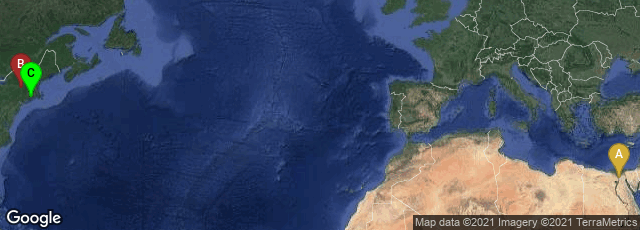
A: Cairo Governorate, Egypt, B: Albany, New York, United States, C: Norwich, Connecticut, United States
At the foot of this broadside preserved in Brown University Libraries we read:
"Chelsea Manufacturing Company. This paper is made by the Chelsea Manufacturing Company, Greeneville, Conn. The largest paper manufactory in the world. The material of which it is made, was brought from Egypt. It was taken from the ancient tombs where it had been used in embalming mummies. A part of the process of manufacturing is exhibited in the procession. The daily production of the Company's mills is about 14,000 pounds."
In 1855 Anglo-American physician, geologist, archaeologist and explorer Isaiah Deck (the younger) published “On a Supply of Paper Material from the Mummy Pits of Egypt,” Transactions of the American Institute of the City of New-York, for the year 1854. (Albany, 1855) 83-93.
"On an earlier copper prospecting trip to Jamaica, Deck had evaluated other sources for paper including aloe, plantain, banana and dagger-grass, but none were acceptable. Thus, already preoccupied with paper and paper sources, Deck set out on a trip to Egypt in 1847 to search for Cleopatra’s lost emerald mines. Deck’s father, also named Isaiah, had known Giovanni Belzoni, a famous Italian robber of Egyptian tombs; Deck the younger thus inherited from his father some Egyptian artifacts, including a piece of linen from a mummy.
"While searching for the lost mines, Deck couldn’t help but notice the plethora of mummies and mummy parts that turned up in communal burial sites called 'mummy pits.' He wrote, 'So numerous are they in some localities out of the usual beaten tracks of most travelers, that after the periodical storms whole areas may be seen stripped of sand, and leaving fragments and limbs exposed in such plenty and variety.' Deck did some calculations: assume two thousand years of widespread embalming, an average life span of thirty-three years and a stable population of eight million. This would leave you with about five hundred million mummies. Add to that the number of mummified animals including cats, bulls and crocodiles, and the number drastically rises. Deck also states, 'it is by no means rare to find above 30 lbs. weight of linen wrappings on mummies…A princess from the late Mr. Pettigrew’s collection was swathed in 40 thicknesses, producing 42 yards of the finest texture.' Deck further calculated that the average consumption of paper in America is about 15 lbs. per person per year. This meant that the supply from Egyptian mummies would be able to keep up with the American demand for about 14 years, by which point a substitute supply source or material would likely have been discovered, rendering the need for rags unnecessary" (Wikipedia article on Mummy Paper, accessed 01-10-2013).
Confirmation that American paper was actually made from rags or papyrus taken from mummies is scarce. One proof is a broadside preserved in Brown University Libraries entitled Hymn for the bi-centennial anniversary of the settlement of Norwich, Conn published in connection with the Bi-Centennial Celebration of Norwich, CT, September 7-8, 1859. At the foot of this broadside we read:
"Chelsea Manufacturing Company. This paper is made by the Chelsea Manufacturing Company, Greeneville, Conn. The largest paper manufactory in the world. The material of which it is made, was brought from Egypt. It was taken from the ancient tombs where it had been used in embalming mummies. A part of the process of manufacturing is exhibited in the procession. The daily production of the Company's mills is about 14,000 pounds."
Wolfe & Singerman, Mummies in Nineteenth Century America. Mummies as Artifacts (2009).